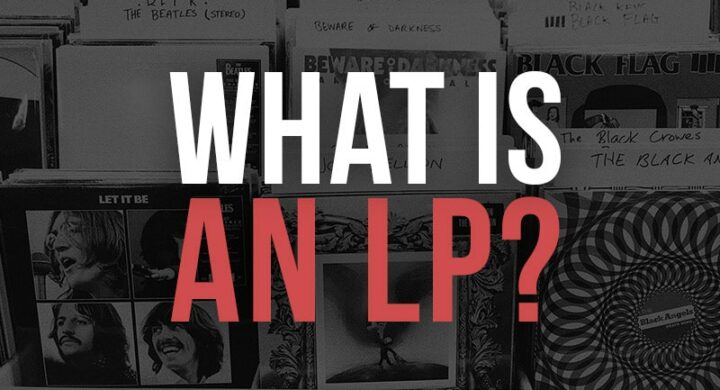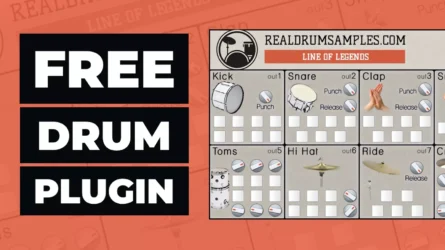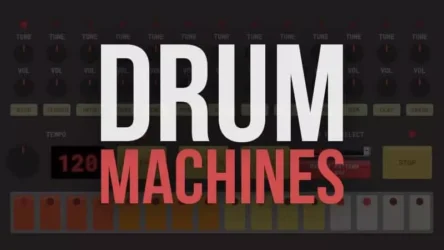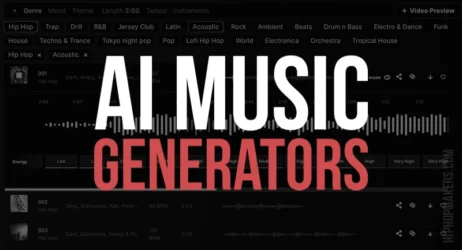Here we will answer what is an LP in music. We provide examples of LP albums and explain the difference between EPs.
- What is an LP in Music
- What Are Examples of An LP
- How Many Songs on An LP
- Why Is It Called an LP
- LP vs. EP Albums
- Benefits of An LP vs EP Album
- How Many Songs On An EP
What Is An LP in Music?
LP stands for “Long Play”, and the term LP initially referred to longer-playing vinyl records. An LP includes an entire album’s worth of music, which can be 12 or more songs. While an EP can have 3 to 9 songs. The word LP has taken on a new meaning to describe CDs and downloads in the digital age.
When it comes to vinyl, LP albums are 12-inch records with tracks on both sides due to the limited storage capacity available on each side.
Vinyl records were the most common means for people to listen to music back in the day. These recordings predate internet streaming, digital downloads, CDs, and even cassettes.

The names LP (Long Play) and EP (Extended Play) were later coined to designate the various forms of music available on vinyl recordings.
An “LP” record included a full album’s worth of music, but an “EP” record contained more music than a single but was less in length and substance than an album.
One of the reasons for the abundance of great record albums in the 1960s and 1970s was the restricted space required to achieve acceptable sound quality on LP recordings.
Musicians had to carefully choose which songs to record, the sequence in which they should be recorded, and, of course, the duration of each track.
Even though individuals still purchase CDs and vinyl records today, internet streaming has become the new norm because of the ease of dissemination on a far larger scale and the near-absence of recording limits.
Thankfully, the terms “LP” and “EP” have found a place in the current music scene, allowing us never to forget where it all began.
When an artist publishes an LP nowadays, it indicates that they are working on a new album. When they release an EP, it indicates they’ll be releasing half of an album.
What Are Examples of An LP?
Vinyl records have made a remarkable recovery from the brink of extinction in recent years due to a renewed interest in the analog format among younger generations.
LP is one of the most crucial definitions to understand whether you’re attempting to get into the music business or want to learn more about vinyl records.
Long Playing vinyl records are referred to as LPs in the music industry. This phrase refers to microgroove vinyl records that spin at 33 and one-third revolutions per minute.
Despite their outdated format, LPs are still in use today. Many individuals prefer the analog sound quality of LP vinyl records to the digital sound that became popular when compact discs were introduced (CD LP).
Some say that an LP is longer than an album, while others argue that an LP is nothing more than an album. Eminem’s Marshall Mathers LP2 is a notable example since it has 22 songs, much more than a typical album, yet it is still referred to as a studio album.
How Many Songs Are On An LP?
Typically, there are seven or more tracks. A full-length album is referred to as an LP. The vinyl media is the only thing that separates an LP from any other album. This implies that the number of tracks on an LP is limited by the bandwidth of the vinyl it is printed on.
With the introduction of CDs and their increased storage capacity, the number of tracks on an album may grow to accommodate this new higher limit. It’s limited to 35 songs on today’s streaming services.
A release with seven or more songs is considered an album by streaming providers. If a release has 1-6 songs but is longer than 30 minutes, it is classified as an album.
When someone speaks about recording a full-length album, they may use the word LP without indicating that they want to publish it on vinyl. Read the context and be aware that these phrases have been flung about at random throughout the years.
Related: What Is A Mixtape
Why Is It Called an LP?
An LP is a long-playing vinyl record in music. A 33 and one-third rpm microgroove vinyl record is often referred to as an LP. These records are still used today. They’re frequently among recordings with “analog” sound qualities instead of the digital sounds popularized by compact discs later on.
LP music became associated with full-length album music throughout time, and this trend persisted into the CD era. As digital music became more widely accessible, LP music began to relate to track numbers. An LP album is typically 10 to 12 tracks long.
Many artists like to use the term LP to describe or allude to an album, even if it’s only available as a CD or digital download.
When it comes to current music, an LP is associated with a full-length album, but an EP is equally vital to comprehend.
What’s the Difference Between LP & EP Albums?
To fully comprehend the differences between an EP and an LP, you’ll need to go into the music business history.
An EP (a short album) or an LP (a complete album) has everything to do with your budget, marketing, and maximizing your earnings.
The abbreviation LP stands for Long Play. It was formerly associated with the standardized 12-inch diameter phonographic record spinning at 33.3 RPMs. Due to the growth of the consumer digital audio format, it now simply refers to a full-length album, the length of which varies greatly.
The term “EP” stands for “Extended Play.” The label has previously and now denoted the publication of a “mini-album,” which is longer than a single but generally half the length of a full-length album. Budget, promotion, and appeal to existing, ardent followers are factors that artists consider when choosing this format.
Here’s a brief recap:
- A full-length album is referred to as an LP in music.
- EP stands for Extended Play in music and refers to a half-length album.
- In the sense that it is lengthier than a single, an EP is called such.
Although there are more specifics, this is the most significant aspect of the topic below: using various formats to advance your music career.
Related: What is an EP?
What Are The Benefits of An LP vs EP Album?
Nearly all phonograph records for household use at the time were constructed of an abrasive (and hence loud) shellac compound. They had a significantly bigger groove and played at about 78 revolutions per minute (rpm), which limited the playing length of a 12-inch diameter record to less than five minutes per side.
The new product was a fine-grooved PVC (“vinyl”) disc with a smaller-tipped “microgroove” stylus that spun at 33+13 rpm and was 12- or 10-inch (30 or 25 cm) in diameter. A 12-inch LP could play for around 22 minutes on each side.
Only the microgroove standard was new since vinyl as well as the 33+13 rpm speed had been utilized for specific reasons for many years, as well as in RCA Victor’s prior failed effort to create a long-playing record for household usage.
Although the LP was designed for classical music because of its long continuous play duration, it also allowed for the compilation of 10 or more pop music recordings on a single disc.
Previously, similar compilations and lengthier classical music divided into sections were marketed assets of 78 rpm recordings in a specially stamped “record album” made out of individual record covers sewn together in book form. For the one-disc LP counterpart, the term “album” was still used.
How Many Songs On An EP?
EPs should contain four to six songs on them. An EP is only considered an EP by iTunes and Spotify if it comprises 4-6 songs.
You’ll probably want more if you want to submit it to record companies so they can get a sense of your style. You want to demonstrate that you have a nice selection of quality tunes.
If your goal is to give it out for marketing, you should include significantly fewer tracks. Because this isn’t an album, you don’t want to give too much away. Your album will include more tracks and will be the next step in the process of people buying into you.
It shouldn’t be so brief that people don’t get a sense of what you’re all about. Don’t scrimp on the value you give if you want to prove you can perform more than one or two terrific tunes.
In other words, don’t have so many songs that you’re giving too much away. But not so few that you don’t give them enough time to listen.
Summary of LPs in Music
LP stands for Long Play. The term LP initially referred to longer-playing vinyl records. Since the digital age, LPs have taken on a new meaning to describe CDs and downloads. An LP album contains 12 or more songs, while EP albums are typically shorter, with 3 to 9 songs.
The LP and EP album formats have a unique place in the world of music. They’re like different ways for a band to serve up a meal of new music to fans.
An LP, or “long play” record, is like a full-course dinner, usually with a hearty collection of songs that give listeners plenty to chew on. On the other hand, an EP, or “extended play,” is like a snack, a bite-sized treat that can whet your appetite for more.
Now, if you’re wondering, “how many tracks make up an LP or EP?” – an LP typically holds a full album with many more songs than an EP. Full-length albums, like LP records, can carry around 10-20 songs depending on the artist and record label’s decisions.
The EP album, on the other hand, generally has fewer songs, perhaps around 3-5. But remember, it’s not always about quantity. Sometimes, it’s about giving fans a taste of what’s to come, releasing singles, or just sharing a creative process.
One of the cool things about EPs and LPs is they come in different formats.
In the past, vinyl records were the go-to choice for music enthusiasts, and even now, they continue to hold a special significance for many fans.
But as technology evolved, so did music releases. Digital formats, like digital downloads or streaming on platforms like Spotify, have become standard. But no matter the format – whether it’s an LP, an EP, a vinyl record, or a digital download – the goal is always to deliver high-quality audio to the listener.
So, what’s the difference between an EP and an LP, really? Think of an EP as an extended single or a mini-album. It’s often used for promotional purposes, maybe to tease a title track of an upcoming LP. The LP, or long-play record, is the full course, the entire release with bonus tracks and everything.
Whether you prefer EPs, LPs, or both, these album formats offer various options to enjoy your favorite music.
Bonus Tip: Always keep an eye out for bonus tracks on LPs. These are extra songs that aren’t part of the album’s main tracklist and are often exclusive to certain formats like vinyl LPs or digital downloads. They can be a fun surprise for music fans and a wonderful way to hear more from your favorite artists!
Remember, no matter if you’re picking up an LP or EP, the most important thing is to enjoy the music.
I hope you found this information on what an LP in Music is helpful. If you have any helpful information to share, please share in the comments.




